South Bluff/Devil’s Nose State Natural Area is the largest forest in southern Wisconsin and has become a big focus of conservation efforts.
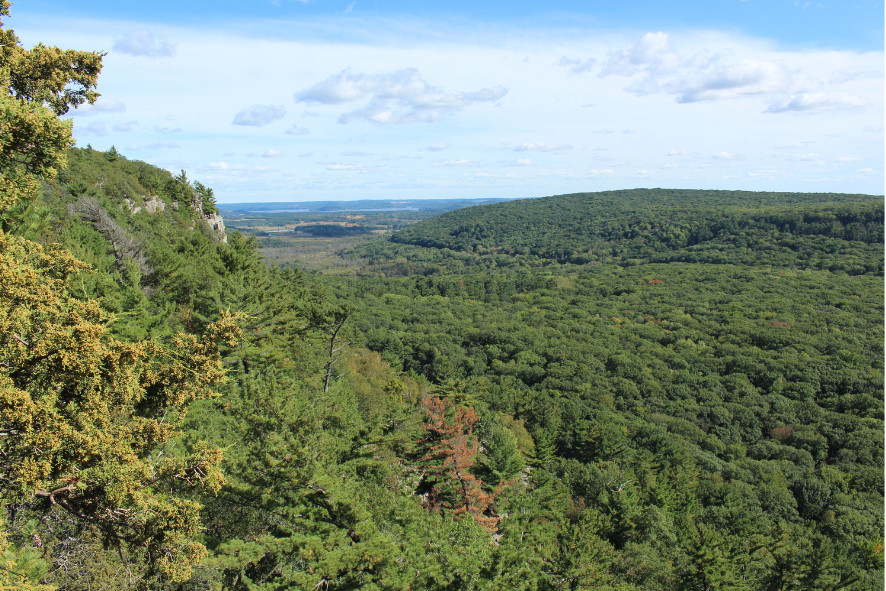
View of South Bluff/Devil’s Nose State Natural Area from an overlook. Photo by Caitlin Williamson
Have you ever entered Devil’s Lake State Park from the east entrance? If so, you may have noticed that you drove through a gigantic forest before reaching the lake. That forest is actually part of the largest uninterrupted tract of forest in Southern Wisconsin. This place, South Bluff/Devil’s Nose State Natural Area, is chock-full of important ecological features and has rightfully become a big focus of conservation and climate adaptation efforts.
How big is South Bluff?
The forest at South Bluff is so big that despite their training in wayfinding, ecologists have actually gotten lost in it! Our friends at the Wisconsin DNR call it a “huge expanse.” At 3,500 acres, it’s roughly the size of a big international airport — ten times the size of Devil’s Lake itself.
Large, continuous habitats are a must for many of Wisconsin’s threatened species. For example, many rare Wisconsin birds require “forest interiors” — forest surrounded by more forest. These habitats are hard to come by these days, when forests are small and separated by roads and other human development. Several species of warbler require these quiet forests, including cerulean, hooded, worm-eating, and yellow-throated. All of these birds are designated as “Species of Greatest Conservation Need” in our state.
South Bluff’s sheer size makes it important for biodiversity, but it also contains some particularly special ecological features. Shady ravines, pine forest, a quartzite gorge, spring-fed streams, bedrock glades, and more provide stellar habitat for plants and animals.
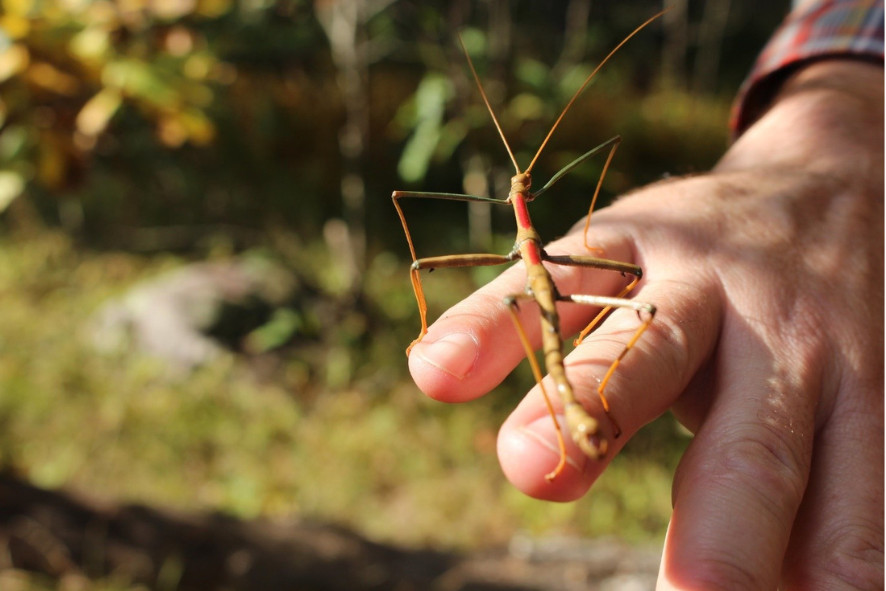
A walking stick found by DNR ecologist Nate Fayram at Devil’s Lake State Park. Photo by Caitlin Williamson
What’s a bedrock glade?
Bedrock glades are open areas of exposed bedrock with small patches of soil, a unique feature of South Bluff/Devil’s Nose. These rocky areas are amazing to look at, but why are they ecologically important?
Back when fires frequently burned across southern Wisconsin, dry, sunny prairies and open oak savannas were once much more prevalent. Many of our state’s conservation challenges stem from the fact that these dry habitats have gradually been taken over by mesic (wet, shady) forests over the last couple of hundred years. But in bedrock glades, many prairie plants have survived. They need more light than they can get under a dense canopy of maples, but in the little patches of soil on top of the quartzite, they have all the sunshine they need.
With the right care, the small populations of rare prairie species that have taken refuge in these bedrock glades could expand. That’s where conservation work at South Bluff is starting.
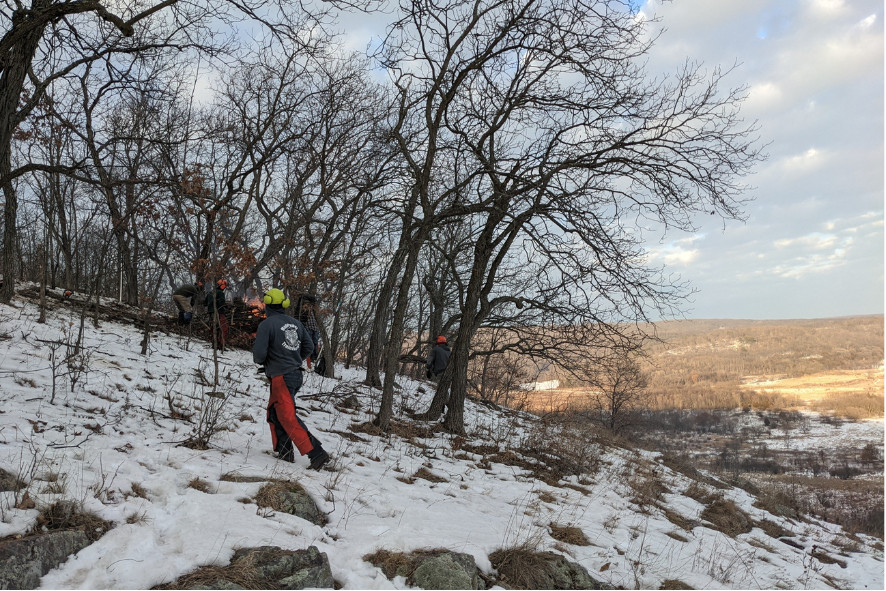
Bedrock glade, a globally imperiled natural community, at South Bluff. Photo by Bridget Rathman
Saving the oaks at South Bluff
Much of the work on the bedrock glades has focused on oaks. “We’ve worked on over 75 acres so far,” says Nate Fayram of the Wisconsin DNR. “The crew has been very active out there this winter.”
In recent decades, lack of fire on this landscape has caused maples to run wild. While we love maples, this is an example of “too much of a good thing.” The maple trees have out-competed young oak trees and have taken over the forest. These days, the forest doesn’t provide nearly as much habitat for our threatened species as the historical oak-dominated forest did. Oaks support more species than maples, particularly the species that have declined in Wisconsin.
South Bluff is one of the only places where we can improve Wisconsin’s rapidly-declining oak ecosystems on a large scale. Removing the excessive maples will allow oaks to reestablish themselves.
There is only a limited amount of time to turn things around – these remaining oaks will reach the end of their lifespan and die if this work doesn’t happen now.
Clearing excessive maples from the bedrock glades has been the first step in improving the forest at South Bluff. Ultimately, NRF and the Wisconsin DNR are planning to restore 1,000 acres of oak forest at South Bluff by 2028.
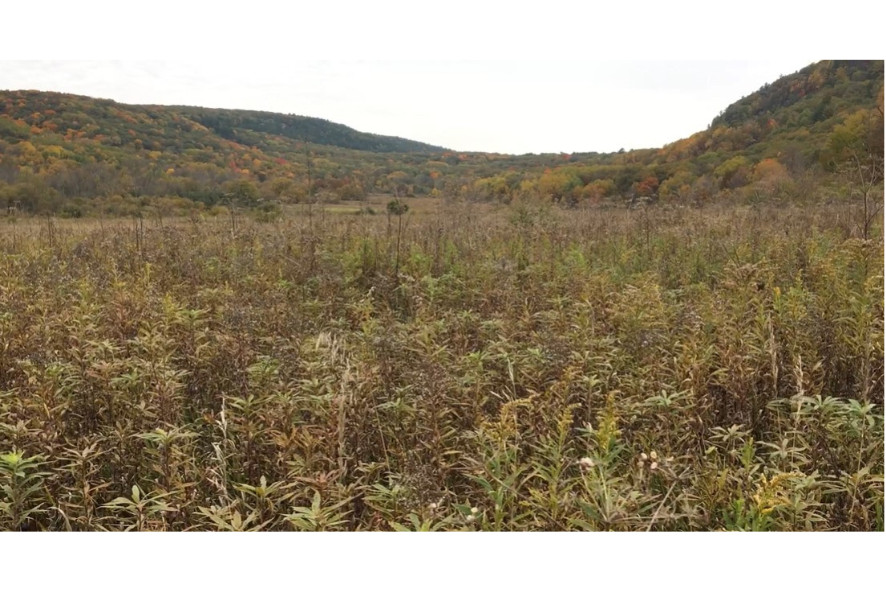
Work to restore a significant portion of the native oak forests at South Bluff has begun. This fall photo shows the maples that have overtaken the landscape. Photo by Shelly Torkelson
Inspired to help
These efforts to restore more oaks to the landscape are happening thanks in large part to support from Ed and Patty Neumueller and Wisconsin’s Climate Response Fund. Since Patty’s passing, Ed has continued to support this work.
“When Patty and I met in the early 1970s we immediately started going camping, then got into birdwatching and learning about prairies,” Ed recalls. As the years went by, they noticed things changing. “So many of the birds we used to see, we don’t see anymore. For example, we used to see red headed woodpeckers everywhere, and now they’re only in more specific habitats. The effect of climate change on prairies and woodlands is gradual, but when a certain bird or species disappears, you notice.”
He agrees that focusing on oaks is a good step. “I’ve always loved oaks. They’re just magnificent, and so many species rely on them. And Devil’s Lake has been important to me since my youth. It’s unique, especially in the southern part of the state, to have something that dramatic looking. I remember taking my son there when he was little and climbing the rocks.”
The desire to protect Wisconsin’s most special places from climate change is a big motivator for Ed. “People who are born today will be in their 70’s at the turn of the next century – what’s going to be around? It’s hard to imagine.”
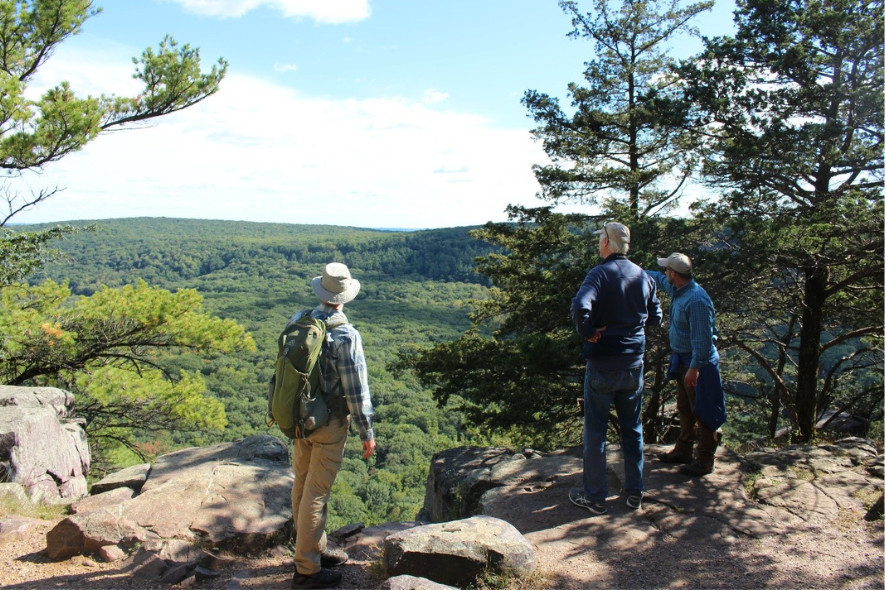
Ecologists from the Wisconsin DNR and Ed Neumueller (middle) at South Bluff/Devil’s Nose State Natural Area. Photo by Caitlin Williamson
Work at the site was also supported in 2023 by NRF’s Cherish Wisconsin Outdoors Fund. This fund is supported by hundreds of thousands of small donations from hunters, anglers, and other outdoor enthusiasts when they renew their annual hunting and fishing licenses.
“You have to live on earth with your eyes open. We all have a responsibility to do something. I’m just trying to do whatever bit I can.”
Preparing for the future
Climate change is here, and we want to be sure we’re protecting the largest forest in southern Wisconsin from its effects. In 2024, NRF supported a Climate Adaptation Workshop for South Bluff to determine what the greatest threats are to the plants and animals there and what to do about it. At the workshop, the group of ecologists, foresters, and the Ho-Chunk nation determined that passively managing the forest will result in huge losses to biodiversity. The group also identified restoring oak ecosystems as a top priority.
This work is ongoing, and the initial clearing of the forest’s bedrock glades is a big step in the right direction. “The bedrock glades, oak woodlands, and forests provide habitat for dozens of rare species,” added Fayram. “NRF’s support has been critical.”
Thank you to Ed Neumueller, our conservation partners including the Wisconsin DNR, the Network for Landscape Conservation’s Catalyst Fund, and NRF’s other donors and members for helping prepare Wisconsin’s forests for climate change. Thank you also to the supporters of all our climate resiliency and landscape-scale conservation work, including the Brico Fund and the Wildlife Conservation Society’s Climate Adaptation Fund.
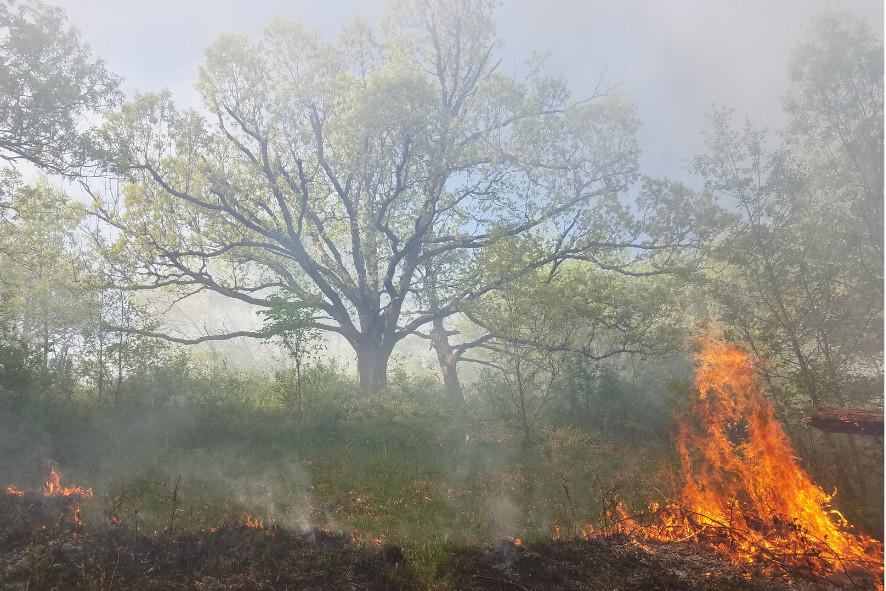
A large oak tree sees its first fire in recent history. Fire is an important tool for keeping oak forests healthy, which supports more wildlife. Photo by Nate Fayram, WDNR
Webinar: Whatever the Weather: Preparing Wisconsin’s landscapes for climate change
The Natural Resources Foundation of Wisconsin hosted a free lunch-hour webinar to learn more about climate adaptation in action across Wisconsin’s landscapes, from the Mississippi River bluffs to the Baraboo Hills, from northern forests and lakes to urban areas.
At the webinar, we discussed a variety of climate adaptation projects in Wisconsin, including Spur Lake and Rush Creek. We also debuted the new short film, “Weathering the Change: Climate Adaptation at Rush Creek.” The film tells the story of climate adaptation efforts at another large important site in Wisconsin, Rush Creek State Natural Area.
Written by Shelly Torkelson, Director of Communications